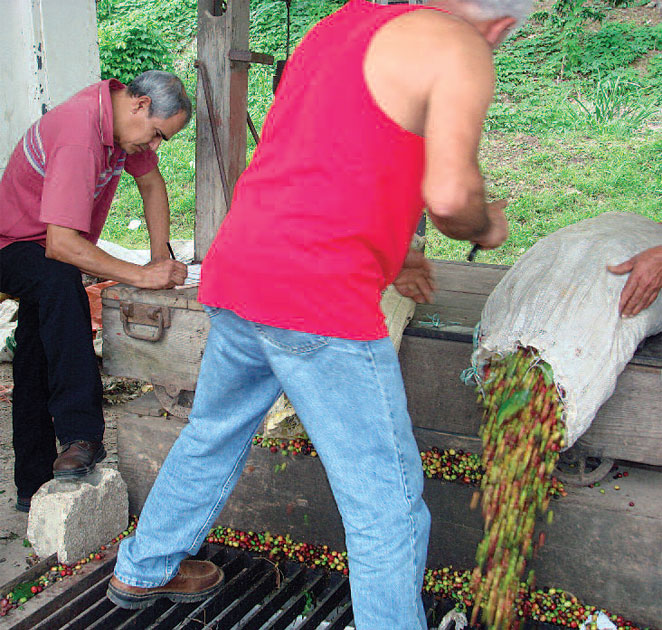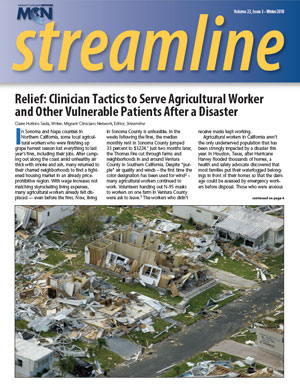
By Claire Hutkins Seda, Writer, Migrant Clinicians Network, Managing Editor, Streamline
Rosa* is a 32-year-old agricultural worker who moves with her husband for work between California, Oregon, and Washington as the seasons progress. When the fires in the Columbia Gorge raged, and the air quality plummeted, the respiratory problems that she had had for years began to flare up. For the first time, she made an appointment at a local health center for this concern and a family nurse practitioner diagnosed her with asthma, prescribed an inhaler, and made recommendations for her to stay indoors while the air quality was poor. Unfortunately, the health center’s intake form didn’t prompt Rosa to disclose that she is an agricultural worker, so the clinician, who was seeing more and more respiratory problems in her patients due to the fires, didn’t realize her advice would pose challenges for her patient who needed to work. Beyond the intake form, nothing prompted the clinician to ask the patient about work during the encounter. This resulted in the clinician missing the opportunity to discuss with Rosa how her asthma may have developed and what on-farm exposures may exacerbate her condition, like harvest dust, chemical exposures, and poor ventilation in out-buildings or in on-farm housing.
In a recent poll of primary care providers participating in a Migrant Clinicians Network (MCN) training, 57 percent stated they had received two hours or less of any training on Environmental and Occupational Health (EOH), both during their health profession schooling and after. And yet, for many clinicians serving vulnerable populations like migratory or seasonal agricultural workers, a deeper understanding of EOH may point clinicians to the underlying and acute conditions that send agricultural workers to the exam room. MCN works to provide clinicians with basic EOH training in primary care, particularly among those serving migratory and seasonal agricultural workers.
“Since its inception, MCN has recognized that occupation is a key social determinant of health for the mobile populations that our clinicians serve. By and large migratory workers are employed in some of the most dangerous jobs, working in industries like agriculture and construction,” said Amy Liebman, MPA, MA, Director of Environmental and Occupational Health at MCN.
To address this important concern, MCN has focused intensive programming and training to help primary care providers improve their recognition and management of occupation-related injuries and illnesses. MCN’s co-Chief medical director, Ed Zuroweste, MD, has worked side-by-side with Liebman and her team on these efforts. “Our aim is to give clinicians basic tools to address these conditions at the primary care level,” said Dr. Zuroweste. “We don’t expect frontline clinicians to become Occupational and Environmental Medicine Specialists, but we do want them to have the training and the basic tools to address work-related conditions in order to improve the quality of care for their patients.”
MCN’s multifaceted approach brings EOH into primary care through careful identification and screening of agricultural workers through intake form and Electronic Health Record adjustments, on-site and distance clinical trainings, as well as resources, technical assistance, and peer-to-peer networking.
Identification through Electronic Health Records: Puerto Rico
Before Hurricane Maria ravaged Puerto Rico, the island had seen a resurgence in agriculture, and health centers around the island were eager to better serve their agricultural worker patients. Migrant Clinicians Network partnered with Hospital General Castañer, a Federally Qualified Health Center, to both better identify agricultural workers through intake questionnaires and to prompt primary care providers to ask about potential occupational exposures.
Jose Rodriguez, MD, Medical Director of Hospital General Castañer, led the efforts at the health center, and had already begun work to expand its reach beyond Hospital General Castañer to health centers throughout the island.
“Incorporating all health centers into this MCN initiative is very important and will be very productive because some health centers already have programs for [agricultural] workers and others do not, so not all are aware of how to serve this population,” Dr. Rodriguez explained.
Better identification of agricultural workers is not just for day-of appointments; health centers can better prepare for disasters if they understand their patient population’s vulnerabilities. Health centers, equipped with the more accurate assessments of patients’ occupations and exposures, can develop emergency preparation and response protocol that take into account vulnerable populations like agricultural workers and their specific needs and risks. While Puerto Rico struggles to recover from Hurricane Maria, better identification of agricultural workers may help health centers prioritize relief efforts and longer-term health and well-being considerations. The Puerto Rico Primary Care Association is leading the coordination of efforts to better document and serve agricultural workers, as communities begin to rebuild.
Trainings to recognize pesticide exposures: Hawaii
In 2016, 19 agricultural workers on the Hawaiian island of Kauai re-entered a research field owned by Syngenta Seeds. Ten of the workers became ill and were transferred to the local hospital for treatment. The field had been recently sprayed with chlorpyrifos, a toxic organophosphate. After the poisoning, the US Environmental Protection Agency along with the Hawaii Department of Health called in Migrant Clinicians Network for an on-site training of primary care providers including first responders to help them better address the recognition and management of pesticide poisonings among agricultural workers. MCN brought in Jimmy Roberts, MD, MPH, a leading expert on the clinical response to pesticide poisoning and a co-author of EPA’s Recognition and Management of Pesticide Poisonings, 6th Edition (RMPP).
Dr. Roberts and Liebman worked with the local hospital and health department to develop improved protocols on treatment, data collection, and care coordination, should another large incident of pesticide poisoning occur. After the training, MCN provided additional technical assistance and networking.

Using the data to enroll in Health Network: Florida
Healthcare Network of Southwest Florida saw quick success after integrating changes to intake forms and EHR prompts to better identify and care for migratory agricultural workers. Within a month of its partnership with MCN, one of their clinics had identified over 50 agricultural workers through its new process. But what happens to workers with chronic concerns after they leave the health center’s service area?
“It’s critical that all parties within the health care team have the training to care for agricultural workers’ environmental and occupational health needs, even as they get ready to move to a new location,” said Dr. Zuroweste. Healthcare Network of Southwest Florida clinicians received training and technical assistance to improve the health center’s systems to recognize and manage occupational and environmental health conditions. This included resources to assist clinicians in identifying its patients working in agriculture, and training on how to enroll patients with any ongoing health condition who intend to move into Health Network, MCN’s bridge case management system.
Health Network keeps up culturally and linguistically appropriate communication with the patient as she moves. A Health Network Associate finds a new clinic and sets up appointments at the patient’s next destination, provides records transfer, and helps with additional case management as needed and available, including arranging transportation to the clinic and helping patients identify and access health resources in their new community. Once a patient completes treatment, records are forwarded to the enrolling clinic to assure accurate reporting. Health Network is unparalleled, providing this service free of charge for all parties and for any ongoing health condition, for patients traveling within the US and to anywhere around the world. For migratory agricultural patients, it is a critical link to enable them to continue treatment despite mobility, which demonstrates how MCN’s EOH approach works with patients from the moment they seek medical care, all the way through multiple migrations as they search for work. In the end, barriers that agricultural workers face are minimized and patients are better able to receive accurate and prompt care.
Read this article in the Winter 2018 issue of Streamline here!
Sign up for our eNewsletter to receive bimonthly news from MCN, including announcements of the next Streamline.
